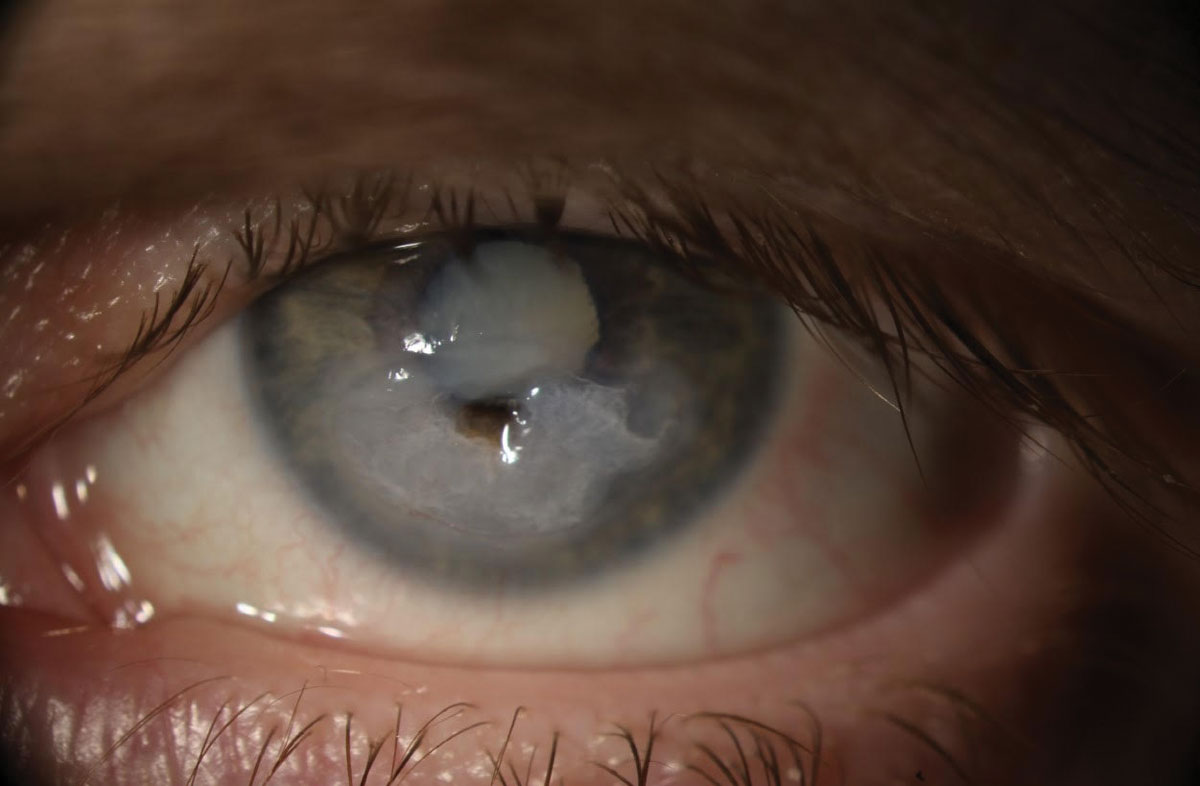 |
| Greater vigilance to corneal denervation in diabetes patients might forestall development of neurotrophic keratitis, a new study argues. Photo: Megan Mannen, OD. Click image to enlarge. |
Just one of the ocular consequences of diabetes is decreased corneal sensitivity, consistent with the other forms of peripheral neuropathy that such individuals can experience. It’s been shown that treatment for DR may further impair corneal sensitivity, but recent reports have shown that eyes receiving anti-VEGF therapy for diabetic macular edema demonstrated impairment of corneal sensation. In a recent study, researchers from San Antonio and Houston assessed the relationship between DR and corneal sensitivity and found that patients with PDR have significantly decreased corneal sensation compared to eyes with NPDR. Eyes with PDR are more likely to demonstrate a greater degree and magnitude of corneal sensitivity loss in all four quadrants as compared to eyes with NPDR. The study was published in American Journal of Optometry.
A total of 100 eyes of 50 patients were enrolled (76% were Black or Hispanic, and 50% were male). Corneal sensitivity was compared in eyes with current or regressed proliferative DR (PDR) (n=35) and eyes with non-proliferative DR (NPDR) with no history of PDR (n=65). Corneal sensitivity in eyes that regressed from PDR to NPDR with anti-VEGF therapy (n=7) was compared to treatment-naïve eyes with no current or prior PDR (n=55) and to eyes with newly diagnosed, treatment naïve PDR (n=12).
In eyes with current or prior PDR, the median corneal sensitivity (average of four quadrants) was 0.5cm, while in eyes with no current or prior PDR, the median corneal sensitivity was 4.75cm. The median corneal sensitivity in eyes with regressed PDR was 0cm, significantly lower than eyes with no current or prior PDR (4.5cm) and no different than eyes with untreated PDR (0cm).
While therapy with anti-VEGF medications can promote vascular regression of PDR, this improvement in DR is not accompanied by recovery of neural corneal sensitivity, the authors noted.
“These findings may challenge the belief that anti-VEGF treatments holistically improve all aspects of diabetes-induced ocular disease characteristics and suggest that a VEGF-independent mechanism is responsible for driving or sustaining corneal nerve damage in diabetes,” the authors wrote in their paper on the study.
In addition, a number of studies suggest that in patients with PDR who demonstrated regression in DR following anti-VEGF treatment, and who were then lost to follow-up and later returned for clinical evaluation, DR outcomes presented much worse compared to those initiated with more traditional therapies, such as PRP.
Because of the high prevalence of diabetic keratopathy (DK) in patients with diabetes, the authors suggest the assessment of corneal sensitivity should be “a standard component of the evaluation of diabetic eye disease.”
“Given the high prevalence of diabetes, such an approach would likely identify high numbers of affected individuals,” the authors wrote. “Ocular surface disease can have a significant negative impact on quality of life, thus identifying affected patients presents an opportunity for intervention, ultimately halting the progression to end-stage NK and potential vision loss. Based on our data, early detection is critical, as reversal of corneal neuropathy was not seen following anti-VEGF therapy even in eyes with beneficial DR responses.”
The authors also suggested in their paper that it’s reasonable to question whether impaired corneal sensitivity could serve as a useful screening test for the presence of DR, given the high rate of comorbidity between DR and DK. “In the US, this method could be useful in settings such as large health screening fairs or primary care offices in an effort to reach those patients who might not have the option to visit a specialist,” they concluded.
Singer M, O’Brien P, Mein L. Corneal sensitivity is inversely correlated with severity of diabetic retinopathy in a predominantly underrepresented population. Amer J Ophthalmol. August 16, 2023. [Epub ahead of print.] |

